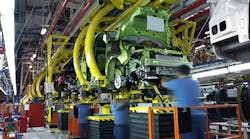Five Steps for Enabling Workforce Readiness
Even as global automakers build new facilities and look to surpass producing 90 million light vehicles for the first time this year (Global Light Vehicle Production Summary, IHS Automotive, March 2016), their workforces are being strained on a number of fronts:
- Automakers are facing skills shortages worldwide. In developed markets, this is largely due to fewer qualified workers available to replace retiring workers and fill new positions. For example, the U.K. today needs 2,500 people to fill immediate vacancies in the auto industry – and it may need 50,000 by 2020 (Employers’ Views of the Jobs and Skills Required for the UK Automotive Industry, Automotive Industrial Partnership, February 2016). In emerging markets, skills shortages in the auto industry are resulting from issues, such as inadequate education, restrictive labor laws and workers lacking the necessary soft skills (Labor Challenges to the Automotive Industry in Emerging Countries, Kelly Services).
- Automotive operations are more complex. Flexible, multiple-model production facilities are taking the place of single-model assembly plants. Vehicle design cycles are shorter, production is continuously running across three shifts, and new and lighter materials are fundamentally changing processes. Workers require training and technology that will help them thrive in these more challenging production environments.
- Smart manufacturing requires new skill sets. Many automakers are in the process of converging their enterprise IT systems and plant-floor operations-technology (OT) systems as part of a smart manufacturing approach. But IT and OT systems have historically remained separate from each other in most plants. As a result, the skill sets of IT and operations personnel have been limited to their individual areas of focus.
Today, these two groups of workers must understand both sides of the IT/OT technology coin to make the most of a unified network infrastructure. This is especially true as more automakers turn to smart manufacturing to support more complex operations.
All told, these workforce challenges could impact automakers’ productivity, lean-manufacturing and growth goals. And as workforces get smaller, workers may feel pressured to seek shortcuts around safety systems in order to maintain productivity levels.
There are no quick or simple fixes for these long-term, multifaceted challenges. But there are five steps automakers can take to help prepare their operations and empower their workers.
1. Improve Machinery Design
Rethinking machinery design can help address ergonomic needs and enhance safety for workers.
For example, hazard assessments should address not only traditional hazards but also ergonomic and usability issues. Engineers who are responsible for performing assessments, building functional specifications and designing machinery should assess all potential operator and maintenance technician movements as part of the process.
Contemporary safety systems that combine standard and safety control systems into one platform can be very effective in mitigating risks while still achieving productive machinery operation. They also are more ergonomic, which can help reduce the likelihood that workers may try to override the systems.
Design strategies, such as safe-speed monitoring and zone control, offer alternative protective measures to lockout/tagout procedures. This can reduce physical demands for workers and reduce machine downtime.
2. Build a Connected Enterprise
A Connected Enterprise is a smart, secure and information-enabled enterprise. Built on a converged network architecture, it enables seamless information sharing across people, processes and technologies.
Automakers can use a Connected Enterprise to address workforce-related productivity and safety challenges in a number of ways:
- Mobile devices enable workers to access critical production information and troubleshoot issues in a format in which they are familiar. For example, Project Stanton, a Rockwell Automation app platform developed in collaboration with Microsoft, allows plant personnel to more easily access, personalize and share data to increase productivity.
- The ability to deliver contextualized instructions to each worker also can reduce complexity for less experienced workers.
- Production intelligence can help reduce downtime. For example, the Zero Downtime tool from FANUC performs real-time condition monitoring and collects diagnostics of robots and other systems to alert workers of issues before a problem occurs.
- Safety-system data can help safety and operations personnel identify risks and better understand where safety-related shutdowns are occurring.
- Remote access enables experienced workers to collaborate with production sites in real-time from a central location, reducing or even eliminating travel
- The ability to retrieve drawings on a mobile device or with the scan of a bar code can simplify troubleshooting and improve utilization of maintenance staff.
3. User Training
Traditionally, OEMs have provided training for stand-alone technology. But in today’s interconnected automotive operations, workers must understand how the systems impact each other.
A holistic training program can help workers keep pace with more complex automotive operations. The program should focus on cross-training and extend beyond a single system or device. It should be customized to the automaker’s plant architecture and be tailored to address worker proficiency, from foundational to mastery-level skills.
When implementing a training program, it’s important to remember that effective programs build on existing talent. That was the case of a major U.S. automaker replacing its legacy equipment with state-of-the-art automation technologies. The company needed to equip its electricians with the knowledge and skills necessary to operate and troubleshoot the new controls system.
Rockwell Automation created a “train-the-trainer” program with custom content for the automaker’s electricians and custom simulator workstations for hands-on instruction. More than 30 in-house trainers were first trained for the rollout in multiple North American plants. In turn, those trainers have since taught more than 1,500 electricians to operate, maintain and troubleshoot the new controls in their home plants.
Lastly, supplemental IT/OT training may be needed for workers responsible for designing, managing and maintaining a Connected Enterprise. Cisco and Rockwell Automation have developed a training and certification program to address this need. Introductory courses provide the foundational skills for managing and administering networked industrial control systems, while more advanced courses dive deeper into industrial protocols, wireless and security implementation, and advanced troubleshooting.
The Industrial IP Advantage, an educational community supported by a coalition of like-minded industry leaders, also offers Web-based training for IT and OT professionals. The four-course, online program covers critical design skills for converged architectures.
4. Collaborate with Service Providers
Working with OEMs, automation vendors and service providers can be especially valuable for skills that are only occasionally required or when local talent isn’t available. They also can provide valuable expertise and support the use of best practices as automakers’ most experienced employees retire.
Examples of key services include:
Network Services: Third-party providers offer continuous network monitoring and maintenance to help automakers manage networks and improve uptime. Free resources, such as the Converged Plantwide Ethernet (CPwE) guides, also can help automakers design and deploy network architectures using best practices (see sidebar).
Safety Assessments: Specialists can conduct machinery safety assessments when the knowledge and skills needed to conduct these assessments aren’t needed on a daily basis.
Remote Services: Remote machine monitoring, data collection and 24/7 live support can
help automakers immediately identify and quickly resolve technical issues, which can be vital for critical processes and continuous operations. For example, Rockwell Automation developed a remote monitoring solution leveraging the Microsoft Windows Azure cloud platform to give users immediate access to dashboards with contextualized real-time and historical production data. This allows service providers to more easily identify trends and troubleshoot issues.
Data-Management Services: Data integration and contextualization are increasingly essential for automakers. Service providers can help with collecting the wealth of data available in a Connected Enterprise and turning it into actionable information.
5. Promote Interest in Manufacturing
Many workers today do not see themselves working in a manufacturing job. They may also have less mechanical experience and too often perceive such jobs as boring or unsafe.
It’s up to automakers and other manufacturers to change this mindset. They also need to educate people that a career in the industry can be both interesting and financially rewarding.
Automakers should actively engage with communities and youth programs to help spark an interest in the automotive industry. And they should help be sure people have the right interdisciplinary skills needed for modern, automotive production jobs.
For example, Rockwell Automation is a strategic partner with the nonprofit organization FIRST. Young people participating in the organization get to experience activities that mirror what manufacturing workers do every day, including working as a team to solve problems and developing solutions with limited resources.
Get Ahead of the Challenges
Automakers that aren’t experiencing workforce challenges today likely will be in the coming years, especially as more workers retire and annual vehicle production marches toward the 100-million mark in 2020 (Global Light Vehicle Production Summary, IHS Automotive, March 2016). Taking action sooner rather than later can get automakers ahead of the challenges before they start to negatively impact profitability, productivity and worker safety.




